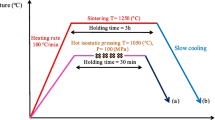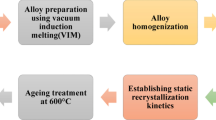Abstract
A Ti-49.8 at. pct Ni alloy was severely deformed at three different temperatures using equal-channel angular extrusion (ECAE). Three deformation temperatures—room temperature (below the martensite finish temperature), 50 °C (below the austenite start temperature), and 150 °C (above the austenite finish temperature)—were selected such that the initial deforming phase (B2 austenite or B19’ martensite) and the initial governing deformation mechanism (martensite reorientation, stress-induced martensitic transformation, or dislocation slip in martensite) would be different. The X-ray analysis results revealed that all processed samples mostly contained a deformed martensitic phase, regardless of the initial deforming phase and the deformation mechanism. Although the martensite start temperature did not change, the austenite start temperature decreased significantly in all deformation conditions, probably because of the effect of the internal stress field caused by the deformed microstructure. All deformation conditions led to an increase in the strength levels and some deterioration of shape-memory characteristics. However, a subsequent low-temperature annealing treatment significantly improved pseudoelastic strain levels while preserving the ultrahigh strength levels. The sample deformed at room temperature followed by the low-temperature annealing resulted in the most promising strength and shape-memory characteristics under compression, such that a 5.3 pct shape-memory strain at a 2200 MPa strength level and a 3.3 pct pseudoelastic strain at a 1900 MPa strength level were achieved. The differences between the strength levels and the shape-memory characteristics after severe deformation at different temperatures were attributed to the different amounts of plastic deformation and the resulting deformation textures, since at each deformation temperature the deformation mechanism was different. It is concluded that the severe marforming using ECAE could easily improve strength levels of NiTi alloys while preserving the shape-memory and pseudoelasticity (PE) characteristics and, thus, improve the thermomechanical fatigue behavior. However, lower deformation temperatures are necessary to hinder formation of macroshear bands, and ECAE angles larger than 90 deg should be used to reduce the amount of strain applied in one pass.
Similar content being viewed by others
References
K. Otsuka and C.M. Wayman: Shape Memory Materials, Cambridge University Press, Cambridge, United Kingdom, 1998.
D. Wurzel: Mater. Sci. Eng. A, 1999, vols. 273–275, p. 634.
E. Hornbogen, V. Mertinger, and D. Wurzel: Scripta Mater., 2001, vol. 44, p. 171.
D.A. Miller and D.C. Lagoudas: Mater. Sci. Eng. A, 2001, vol. 308, p. 161.
E. Hornbogen: Mater. Sci. Eng. A, 1999, vols. 273–275, p. 630.
J.C. Ewert, I. Bohm, R. Peter, and F. Haider: Acta Mater., 1997, vol. 45, p. 2197.
Y. Liu: Mater. Sci. Eng. A, 1999, vols. 273–275, p. 668.
H.C. Lin and S.K. Wu: Acta Metall. Mater., 1994, vol. 42, p. 1623.
Y. Liu and D. Favier: Acta Mater., 2000, vol. 48, p. 3489.
H. Nakayama, K. Tsuchiya, Z.G. Liu, M. Umemoto, K. Morii, and T. Shimizu: Mater. Trans. JIM, 2001, vol. 42, p. 1987.
Y. Liu and S.P. Galvin: Acta Mater., 1997, vol. 45, p. 4431.
H. Nakayama, K. Tsuchiya, and M. Umemoto: Scripta Mater., 2001, vol. 44, p. 1781.
E. Hornbogen: J. Mater. Sci., 1999, vol. 34, p. 599.
H.C. Lin, S.K. Wu, T.S. Chou, and H.P. Kao: Acta Metall. Mater., 1991, vol. 39, p. 2069.
L.M. Schetky: Robotics Age, 1984, vol. 14, p. 13.
C.M. Wayman: in Phase Transformations, Physical Metallurgy, R.W. Cahn and O. Haasen, eds., Elsevier, New York, NY.
B.J. deBlonk and D.C. Lagoudas: Smart Mater. Struct., 1998, vol. 7, p. 771.
R.Z. Valiev, R.K. Islamgaliev, and I.V. Alexandrov: Prog. Mater. Sci., 2000, vol. 45, p. 103.
L.R. Cornwell, K.T. Hartwig, R.E. Goforth, and S.L. Semiatin: Mater. Characterization, 1997, vol. 38, p. 119.
J. Robertson, J.-T. Im, I. Karaman, K.T. Hartwig, and I.E. Anderson: J. Non-Crystalline Solids, 2003, vol. 317, pp. 144–51.
H. Sitepu, W.W. Schmahl, J.K. Allafi, G. Eggeler, A. Dlouhy, D.M. Toebbens, and M. Tovar: Scripta Mater., 2002, vol. 46, p. 543.
H.F. Lopez: Mater. Lett., 2001, vol. 51, p. 144.
A.A. Bulbich and P. Toledano: Phys. Rev. Lett., 1998, vol. 81, p. 838.
Y.F. Zheng, J.X. Xhang, L.C. Zhao, and H.Q. Ye: Mater. Lett., 1999, vol. 41, p. 9.
M. Piao, K. Otsuka, S. Miyazaki, and H. Horikawa: Mater. Trans. JIM, 1993, vol. 34, p. 919.
Y. Liu and G.S. Tan: Intermetallics, 2000, vol. 8, p. 67.
H. Sehitoglu, I. Karaman, R. Anderson, X.Y. Zhang, K. Gall, H.J. Maier, and Y.I. Chumlyakov: Acta Mater., 2000, vol. 48, p. 3311.
F. Khelfaoui, G. Thollet, and G. Guenin: Mater. Sci. Eng. A, 2002, vol. 338, p. 305.
H. Sehitoglu, J. Jun, X. Zhang, I. Karaman, Y. Chumlyakov, H.J. Maier, and K. Gall: Acta Mater., 2001, vol. 49, p. 3609.
K. Gall, T.J. Lim, D.L. McDowell, H. Sehitoglu, and Y.I. Chumlyakov: Int. J. Plast., 2000, vol. 16, p. 1189.
V.M. Segal: Mater. Sci. Eng. A, 1999, vol. 271, p. 322.
H.J. Bunge, Y. Perlovich, M. Isaenkova, V. Fesenko, and R. Rustamov: Text. Microstr., 1998, vol. 31, p. 53.
Y. Perlovich, H.J. Bunge, M. Isaenkova, and V. Fesenko: Mater. Sci. Forum, 2002, vols. 408 (4), p. 1145.
T.H. Nam, T. Saburi, Y. Nakata, and K. Shimizu: Mater. Trans. JIM, 1990, vol. 31, p. 1050.
K. Otsuka, T. Sawamura, and K. Shimizu: Phys. Sta. Sol. (a), 1971, vol. 5, p. 457.
Author information
Authors and Affiliations
Rights and permissions
About this article
Cite this article
Karaman, I., Karaca, H.E., Luo, Z.P. et al. The effect of severe marforming on shape memory characteristics of a Ti-rich NiTi alloy processed using equal channel angular extrusion. Metall Mater Trans A 34, 2527–2539 (2003). https://doi.org/10.1007/s11661-003-0012-5
Received:
Issue Date:
DOI: https://doi.org/10.1007/s11661-003-0012-5




